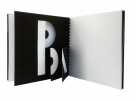OCKERSE THOMAS (né en 1940)
The A-Z Book
1969 Colorcraft-Brussel Publishing, New York, 1969. 280x285mm, 26p. sous couverture cartonnée et reliure spirale plastique, boîte titrée.
Reference : 102009
The A-Z Book est un abécédaire pour tous les âges. Thomas (Tom) Ockerse a conçu ce livre en 1964, durant ses études de graphisme à l’université de Yale. En 1969, le MoMA souhaita de le publier mais le coût de fabrication en était trop élevé. Françoise Boas de l’imprimerie «Color-craft Lithographers Inc.,» qui avait fait un devis pour le MoMA, souhaita le publier à son compte. Le tirage prévu de 2000 exemplaires ne fut pas réalisé à cause des problèmes de reliure et d'assemblage.
Bookseller's contact details
Librairie Chloé et Denis Ozanne Déesse sarl
M. Denis Ozanne
21 rue Monge
75005 Paris
France
+33 1 48 01 02 37
Payment mode



Sale conditions
Conforme aux usages de la librairie ancienne et moderne, tous les ouvrages présentés sont complets et en bon état, sauf indication contraire. L'exécution des commandes téléphonées est garantie mais sans règle absolue, la disponibilité des livres n'étant pas toujours vérifiable lors de l'appel. Les frais de port sont à la charge du destinataire. Les livres sont payables à la commande. Nous acceptons les règlements par chèque bancaire ou postal, mandat postal ou international, carte bancaire, Visa, Eurocard, MasterCard et virements bancaires dans certaines conditions.
5 book(s) with the same title
Reference : alb60d0e70c6d291c4e
Bibliographic Yearbook: Yearbook of the State Central Book Chamber of the RSFSR
Bibliographic Yearbook: Yearbook of the State Central Book Chamber of the RSFSR. In nine issues In Russian /Bibliograficheskiy ezhegodnik: Ezhegodnik Gosudarstvennoy tsentralnoy knizhnoy palaty RSFSR. V devyati vypuskakh 1) Book in 1921 1922. (2) Book in 1922-23. (3) Book in 1923-1924. (4) Book in 1924. (5) Book in 1925. (6) Book in 1926. (7) Book in 1927. (8) Book in 1928. (9) Book in 1929. (9) Book in 1929. (M.P.-L.: Book Publishing Company, State Publishing Company, State Socio-Economic Publishing Company, 1923-1931.) Complete set of nine editions of the Yearbook, published after a hiatus related to the First World War and Civil War. (1) Book in 1921-1922. (Bibliographic review. We have thousands of titles and often several copies of each title may be available. Please feel free to contact us for a detailed description of the copies available. SKUalb60d0e70c6d291c4e.
Crafting Knowledge in the Early Medieval Book. Practices of Collecting and Concealing in the Latin West
, Brepols, 2023 Paperback, 524 pages, Size:178 x 254 mm, Illustrations:7 b/w, 19 col., 22 tables b/w., Language: English. ISBN 9782503602479.
Summary Collection and concealment were hallmarks of early medieval book culture. Materials of all kinds were collected, collated, concealed, condensed, correlated, paraphrased, reorganised, and repurposed in early medieval manuscripts. This volume of essays explores how knowledge was made in the early medieval book in the Latin West through two interrelated practices: collecting and concealing. It provides case studies across cultures and areas (e.g. exegesis, glossography, history, lexicography, literature, poetry, vernacular and Latin learning). Collectio underpinned scholarly productions from miscellanies to vademecums. It was at the heart of major enterprises such as the creation of commentaries, encyclopaedic compendia, glosses, glossaries, glossae collectae, and word lists. As a scholarly practice, collectio accords with the construction of inventories of inherited materials, the ruminative imperative of early medieval exegesis, and a kind of reading that required concentration. Concealment likewise played a key role in early medieval book culture. Obscuration was in line with well-known interpretative practices aimed at rendering knowledge less than immediate. This volume explores the practices of obscuring that predate the twelfth-century predilection, long recognised by historians, for reading that penetrates beneath the ?covering? (integumentum, involucrum) to reveal the hidden truth. Cumulatively, the papers spotlight the currency of two crucial practices in early medieval book culture - the practices of collection and concealment. They demonstrate that early medieval authors, artists, compilers, commentators, and scribes were conspicuous collectors and concealers of knowledge. TABLE OF CONTENTS Sin ad O'Sullivan, Collecting and Concealing in the Field of the World Anna A. Grotans, Understanding the Scope of Knowledge in Early Medieval St Gall Mariken Teeuwen, The Intertwining of Ancient and Late-Antique Authorities in the Margins of Carolingian Manuscripts Michael W. Herren, Philology and Mercury after the Wedding: Truth and Fiction in Three Didactic Works David Ganz, Latin Shorthand and Latin Learning Franck Cinato, Critical Cumulation? How Glossaries were Constituted in the Early Middle Ages (6th-8th Centuries) Patrizia Lendinara, Unveiling the Sources of the Glosses to the Third Book of the Bella Parisiacae Urbis by Abbo of Saint-Germain-des-Pr s Rosalind C. Love, ?But what Polybius the Greek Physician Says is More Correct?: Sources of Knowledge in the Glosses to Boethius's Consolation of Philosophy at Tenth-Century Canterbury Kees Dekker, Collecting Encyclopaedic Knowledge in the Vocabularius Sancti Galli Evina Stein, Early Medieval Catechetic Collections Containing Material from the Etymologiae and the Place of Isidore of Seville in Carolingian Correctio John J. Contreni, Hic continentur ista: Collecting and Concealing in an Early Ninth-Century Instruction-Reader (Laon, Biblioth que Municipale ?Suzanne Martinet,? MS 265) Ildar Garipzanov, Graphic Ciphers and the Early Medieval Practices of Collectio and Concealment Andy Orchard, Building a Splendid Library: The Background and Context of the Bibliotheca magnifica Michael James Clarke, Medieval Scholarship and Intertextuality: A Case Study of Saxo Grammaticus on the Giants Ciaran Arthur, Harvesting Wisdom from Books and the Beauty of the Unknown Index of Manuscripts General Index
Reference : alb7b6bcf578ef0576e
The Significances in the First Journal-book and the Charter-book of the Royal So
The Significances in the First Journal-book and the Charter-book of the Royal Society. In English (ask us if in doubt)/The Signatures in the First Journal-book and the Charter-book of the Royal Society.The Significances in the First Journal-book and the Charter-book of the Royal Society.. SKUalb7b6bcf578ef0576e.
Reference : alb35b319fe4f97ec5f
Sanderson B. The Buresvet Archive: Book 1-The Way of Kings: Book 2-The Words o
Sanderson B. The Buresvet Archive: Book 1-The Way of Kings: Book 2-The Words of Merger: Book 3-The Oath (2 tts): Book 4-The Rhythm of War (2 tts). In Russian /Sanderson B. Arkhiv Buresveta: Kn. 1-Put koroley: Kn. 2-Slova sliyaniya: Kn. 3-Davshiy klyatvu (2 tt.): Kn. 4-Ritm voyny (2 tt.). Series: Stars of the New Fantasy. ABC, ABC-Atticus, 2019-2021 from 672 to 1248 pp. We have thousands of titles and often several copies of each title may be available. Please feel free to contact us for a detailed description of the copies available. SKUalb35b319fe4f97ec5f.
Milyukov P.N. The Ancient Discharge Book of the Official Editorial Board. (Throu
Milyukov P.N. The Ancient Discharge Book of the Official Editorial Board. (Through 1565) In Russian (ask us if in doubt)/Milyukov P.N. Drevneyshaya razryadnaya kniga ofitsial'noy redaktsii. (Po 1565 g.) Short description: In Russian (ask us if in doubt).The book includes a historian's study of the official text of the most ancient book and the text of a well-known historical document. This text was compiled in 1556 and has reached us in several lists. The purest and oldest version of the official text is a manuscript written in the sixteenth century. This manuscript is the basis for the publication and the text of the book is printed on it. We have thousands of titles and often several copies of each title may be available. Please feel free to contact us for a detailed description of the copies available. SKUalbcdc4b3ba94616911
 Write to the booksellers
Write to the booksellers


